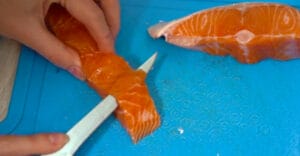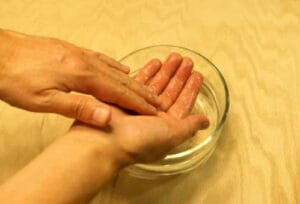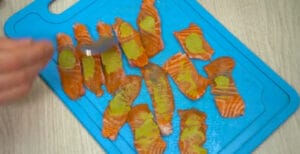Learn how to make nigiri sushi at home with this easy recipe and tips from James at Food And Meal. Get step-by-step instructions on shaping sushi rice and assembling beautiful nigiri sushi
Hey everyone, James here! I’m so excited to share this new recipe for homemade nigiri sushi on the Food And Meal. As many of you know, I have a deep passion for Japanese cuisine. There’s just something about the fresh flavors, beautiful presentation, and artful techniques that speaks to my soul.
Recently, I’ve really been craving those perfect little parcels of vinegared rice topped with the freshest fish or vegetables. There’s no denying that sushi always makes me feel happy and satisfied. But I have to admit, I’ve been a bit intimidated to try making it at home. Shaping the rice and slicing the fish with such precision seemed daunting.
However, I decided it was time to face my fears! I did some research on traditional nigiri sushi making techniques and found that it’s actually quite simple with a little practice. Once I gathered the basic ingredients like sushi rice, nori sheets, and fresh salmon, I was ready to give it a try.
The first few attempts were a bit messy, I’ll be honest! But with each try, I got better at handling the sticky rice and forming it into those perfect little oval shapes. Topping it off with thinly sliced salmon and a brush of soy sauce felt so deeply rewarding.
Now, I can’t get enough homemade nigiri staples! I find the whole process therapeutic and love tailoring it to my taste with different fillings. I’m so thrilled to share my tips and tricks for making Japanese restaurant-quality nigiri sushi right in your own kitchen.
So grab your aprons and let’s get rolling! This recipe is sure to bring joy and happy tummies for the whole family.
How to make Nigiri Sushi
Nigiri sushi meaning ?
Nigiri Sushi is a style of sushi that features a small, oval mound of rice topped with a raw fish. This type of sushi is made by hand and is usually accompanied by wasabi and garnish. Its most common ingredients are salmon, albacore, and tuna. Although many other seafood varieties are available, albacore is the most common. This type of sushi is also known as sashimi.
Nigiri is the most popular type of sushi, with special types of fish like salmon, halibut, or bluefin tuna. The fish is firm and rich in fat, so the flavor will melt in your mouth. It’s served with soy sauce, wasabi, or wasabi to enhance its flavor. The fish is often pan-seared and served with a drizzle of soy sauce and pickled ginger.
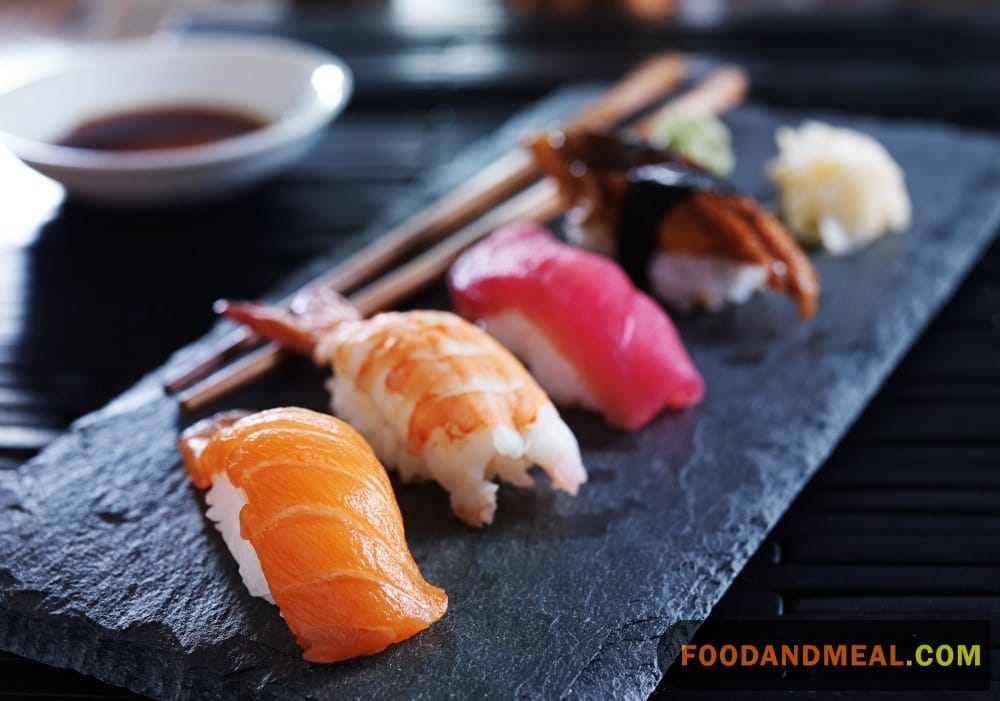
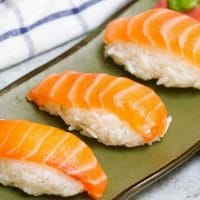
Nigiri Sushi
Equipment
Ingredients
- 4-6 ounce piece sushi-grade tuna or salmon
- 3 cups sushi rice About 3 cups, prepared
- Tezu solution for washing hands
- Wasabi
Instructions
- If using salmon, cover the fish with salt and leave it for 1 hour. Rinse off the salt and put the salmon into the freezer until it is completely frozen.

- Defrost until it is easy to slice.

- Slice the fish very thinly, about ½ inch thick and the size of a domino.

- Dip hands into the tezu. ( Tezu refers to a solution of water and salt used to moisten the hands while making sushi or other dishes. This helps prevent the rice from sticking to the hands and keeps the hands moist for easy handling of ingredients. )

- Take a scoop of sushi rice to fit your fist. Pack the rice in your fist to make a small rectangle of sushi rice.

- Dab one side of the fish slices with wasabi and place it, wasabi side down, on the sushi rectangle.

- Serve with more wasabi, soy sauce, and sushi ginger.

Video
Notes
Nutrition
© Food And Meal
This website provides approximate nutrition information for convenience and as a courtesy only. Nutrition data is gathered primarily from the Spoonacular Database, whenever available, or otherwise other online calculators.
Alternative Method: Nigiri Sushi Rice Cooker Rolls
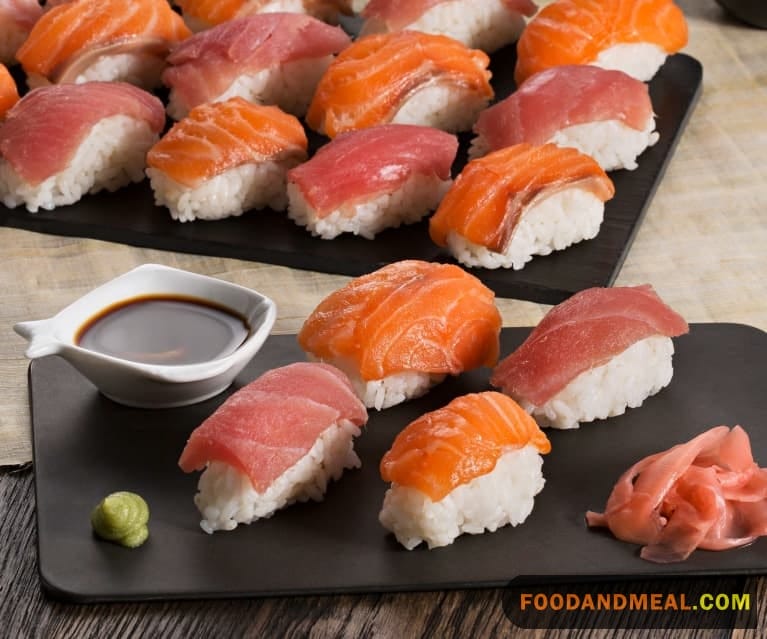
Ingredients:
- 2 cups sushi rice
- 1/4 cup rice vinegar
- 2 tablespoons sugar
- 1/2 teaspoon salt
- Assorted sushi fillings (e.g., avocado, cucumber, cooked and seasoned shrimp)
- Nori (seaweed) sheets
- Soy sauce, pickled ginger, and wasabi for serving
Instructions:
- Prepare Sushi Rice: Rinse the sushi rice until the water runs clear. Cook the rice in a rice cooker following the manufacturer’s instructions.
- Season the Rice: While the rice is still hot, transfer it to a mixing bowl. In a separate bowl, combine the rice vinegar, sugar, and salt. Gently heat this mixture until the sugar and salt dissolve. Pour it over the cooked rice and fold it in, ensuring even distribution.
- Assemble the Rice Cooker Rolls: Lay a sheet of plastic wrap on a clean surface. Place a sheet of nori on top, shiny side down. Wet your hands to prevent sticking, and take a small handful of seasoned rice. Spread it evenly on the nori, leaving about half an inch of nori at the top uncovered.
- Add Fillings: Arrange your choice of sushi fillings, such as thin strips of avocado, cucumber, or seasoned shrimp, in the center of the rice.
- Roll and Seal: Using the plastic wrap, carefully roll the nori and rice over the fillings. Apply gentle pressure to create a tight roll. Moisten the uncovered strip of nori and press it to seal the roll.
- Slice and Serve: Unwrap the roll and use a sharp, wet knife to slice it into bite-sized pieces. Arrange the Nigiri Sushi Rice Cooker Rolls on a platter and serve with soy sauce, pickled ginger, and wasabi.
Difference between sushi and nigiri
While sushi and nigiri are closely related, there are some key differences between the two:
- Sushi refers to any dish made with vinegared rice, while nigiri specifically refers to the iconic type of sushi made of hand-pressed rice with a topping. Common nigiri toppings include raw fish, seafood, or vegetables.
- Nigiri sushi has a compact oblong shape, whereas styles like maki rolls are cylindrical and uramaki rolls are inside-out rolls. The rice in nigiri compresses the topping so it doesn’t fall off easily.
- Nigiri sushi showcases the topping, usually only having a thin slice or piece adorning the rice. With maki rolls, fillings are enclosed within the roll.
- The rice in nigiri sushi also tends to be warmer and softer compared to rolls which leads to a different mouthfeel. Nigiri is usually eaten with fingers rather than chopsticks.
- While authentic nigiri should always be topped with something, sushi rice can also be served alone as a side dish. This would not be considered true nigiri.
So in summary – all nigiri sushi is sushi, but not all types of sushi are nigiri! Nigiri refers specifically to the iconic hand-pressed compact rice with topping style.
Tips for making Nigiri Sushi
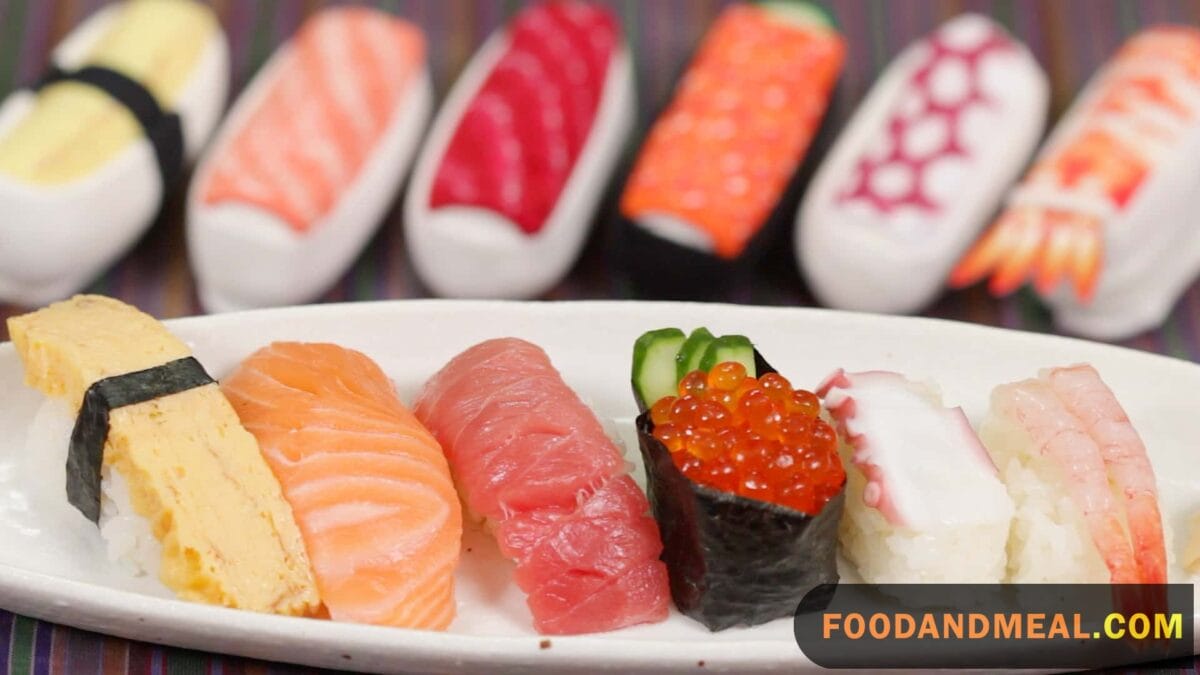
Serving Suggestions
Nigiri sushi is a versatile dish that pairs well with many flavors. Here are some serving suggestions to complement the homemade nigiri:
- Serve with a light salad like mesclun greens or seaweed salad to balance the richness of the sushi rice and fish. A soy-ginger or ponzu dressing would pair nicely.
- For a heartier meal, nigiri goes well with rice bowls like gyudon beef bowl, chicken teriyaki bowl, or bibimbap. The contrast of flavors and textures is very satisfying.
- Miso soup and edamame make classic Japanese starters to the meal. Their delicate umami flavors won’t overpower the nigiri.
- Fresh fruit like mango, peach, or watermelon make refreshing desserts after eating nigiri. The sweetness helps cleanse the palate.
- Iced green tea, hot sake, or Asian beers like Sapporo are ideal beverage pairings with nigiri as they won’t clash with the vinegar and delicate fish flavors.
I aimed to suggest dishes that would complement rather than compete with the lovely homemade nigiri flavors. Balancing textures, flavors, and colors can make for beautiful, appetizing meals. Please let me know if you need any other serving recommendations!
Homemade nigiri Tips
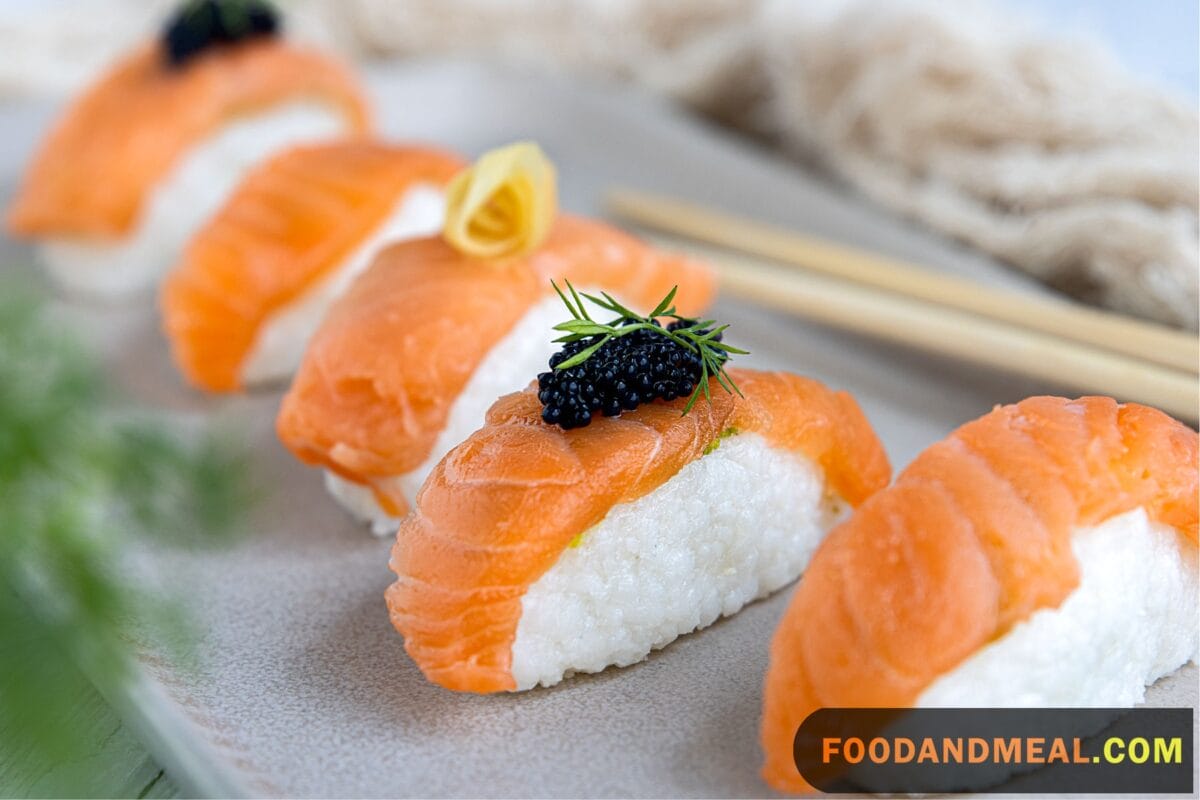
- Quality of Fish: If you’re using raw fish, make sure it’s sushi-grade and sourced from a reputable supplier. Freezing the fish before use can also reduce the risk of parasites.
- Rice Preparation: Rinse the sushi rice thoroughly until the water runs clear to remove excess starch. Use a rice cooker or follow the stovetop method to cook the rice. Once cooked, season it with a mixture of rice vinegar, sugar, and salt while it’s still warm.
- Wet Hands: Keep a small bowl of water nearby when shaping Nigiri. Wet your hands to prevent the rice from sticking. It’s essential for shaping the rice and maintaining its perfect texture.
- Perfect Rice Size: When forming the rice, aim for bite-sized portions that fit easily in your mouth. Nigiri should be delicate and not overly large.
- Freshness Matters: The essence of Nigiri lies in the freshness of your ingredients. Whether it’s the fish, vegetables, or garnishes, ensure they are of the highest quality.
- Gently Firm but Not Crush: While shaping the rice, apply gentle pressure to make it adhere to the fish or other toppings. However, don’t squeeze too hard, as Nigiri should maintain a delicate texture.
- Nori Sheets: When using nori for rolls or as a base for Nigiri, ensure it’s crispy. To achieve this, gently toast the nori sheets over a low flame or use a microwave for a few seconds.
FAQs about Nigiri Sushi
- Can I make Sushi Nigiri with brown rice for a healthier option? Yes, you can. However, keep in mind that brown rice has a firmer texture, which can be slightly challenging to shape into Nigiri. Opt for slightly overcooked brown rice, seasoned with vinegar, for better results.
- How do I store leftover Nigiri Sushi? Leftover Nigiri should be refrigerated promptly. Store it in an airtight container with a damp paper towel to prevent rice from drying out. Consume it within 24 hours for the best taste and quality.
- Is it essential to use sushi-grade fish for Nigiri? While sushi-grade fish is recommended for safety, you can enjoy Nigiri with fully cooked or vegetarian fillings. Ensure any raw fish is properly sourced, frozen, and thawed to minimize health risks.
- Can I make Nigiri Sushi in advance for a party? It’s best to assemble Nigiri shortly before serving to maintain the best texture and flavor. You can, however, prepare components like seasoned rice and sliced fillings in advance to streamline the process.
- What are some creative Nigiri toppings beyond traditional fish? Get imaginative with toppings like seared scallops, marinated tofu, quail eggs, or even fruits like mango for a unique twist on Nigiri. Experiment and discover your own signature Nigiri creations.
- What is the rice-to-water ratio for sushi rice in a Japanese rice cooker? Generally, use a ratio of 1 cup of sushi rice to 1.25 cups of water. Follow the markings on the inner pot of your rice cooker for more accurate measurements.
Conclution
I hope you all enjoyed this recipe for homemade nigiri sushi as much as I did! Now that I’ve gotten the techniques down, I find the process utterly calming and gratifying. Molding the rice just right and topping it with the freshest ingredients is so rewarding, not to mention delicious!
I encourage you all to give nigiri sushi a try at home – don’t be intimidated like I once was. With a little practice, you’ll be churning out restaurant-quality sushi in no time that looks beautiful and tastes even better.
Let me know in the comments if you have any other sushi recipes you’d like for me to tackle. I had so much fun making this classic nigiri, I can’t wait to experiment with more fillings and styles soon.
Thanks for following along on my sushi-making journey. Here’s to many more happy and healthy homemade meals ahead! Itadakimasu!
I'm James F Anderson, a noted sous chef from London and a Le Cordon Bleu alumnus. My career began in a Michelin-starred Parisian eatery, where my blend of classic and contemporary cooking, using seasonal ingredients, earned accolades. Recognized in culinary publications and on cooking shows, I’m committed to mentoring aspiring chefs and delivering memorable dining experiences, marking me as a standout talent in the culinary world.


